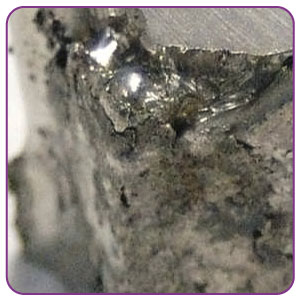
| Symbol | Ni |
| Atomic Number | 28 |
| Atomic Mass | 58.693 |
| Discovered by | Nickel was discovered by Axel Fredrik Cronstedt |

Chemical Properties Of Nickel
| Group | 10 | Melting point | 1455°C, 2651°F, 1728 K |
| Period | 4 | Boiling point | 2913°C, 5275°F, 3186 K |
| Block | d | Density (g cm−3) | 8.90 |
| Atomic number | 28 | Relative atomic mass | 58.693 |
| State at 20°C | Solid | Key isotopes | 58Ni |
| Electron configuration | [Ar] 3d84s2 | CAS number | 7440-02-0 |
| ChemSpider ID | 910 | ChemSpider is a free chemical structure database | |
Table of Contents
- What is Nickel?
- Uses Of Nickel
- Properties Of Nickel
- Certain Facts About Nickel
- [NiCl4]2− Geometry
- Frequently Asked Questions – FAQs
What is Nickel?
- Nickel is a transition metal, with an atomic number of 28, located in the fourth period/row on the periodic table of elements. It is an essential nutrient for the body but its over intake can cause harm. Humans can get the infection by breathing in infected air or drinking such water or eating such food or smoking cigarettes. Too much nickel consumption can cause Lung cancer, Nose cancer, Larynx cancer, and Prostate cancer.
Uses Of Nickel
- The most crucial use of this element is that it is used to make coins.
- It is used in making wires.
- It is used in gas turbines and rocket engines as it has the capability to resist corrosion even at high temperatures.
- It is used to make a variety of alloys which are further used to make armour plating, nails, or pipes.
- Monel (alloys of nickel and copper), is a hard compound and can resist corrosion by seawater. Hence, it is used in propeller shafts in boats and desalination plants.
Properties Of Nickel
- Nickel is a silvery-white, hard, malleable, and ductile metal.
- It is a good conductor of heat and electricity.
- It is bivalent, that is it has a valency of two.
- The metal dissolves slowly in dilute acids.
- Its melting point is 1453 °C and its boiling point is 2913 °C.
Certain Facts About Nickel
- As it is radioactive metal, it is toxic and harmful to life.
- The compound of 99Tc is very contaminative in nature and hazardous for life.
- One must use a safety glove box while handling the chemical.
[NiCl4]2− Geometry
Ni2+ undergoes sp3 hybridization to make bonds with Cl– ligands in a tetrahedral geometry. As there are unpaired electrons in the d-orbitals, [NiCl4]2− is paramagnetic and is referred to as a high spin outer orbital complex. Therefore [NiCl4]2− are tetrahedral.
Frequently Asked Questions – FAQs
Is [NiCl4]2− paramagnetic?
Though both [NiCl4]2− and [Ni(CO)4] are tetrahedral, their magnetic characters are different. This is due to a difference in the nature of ligands. Cl- is a weak field ligand and it does not cause the pairing of unpaired 3d electrons. Hence, [NiCl4]2− is paramagnetic.
Why is [Ni(CN)4]2- square planar?
In presence of strong field CN– ions, all the electrons are paired up. The empty 4d, 3s and two 4p orbitals undergo dsp2 hybridization to make bonds with CN– ligands in square planar geometry. Thus [Ni(CN)4]2- is square planar.
What is the IUPAC name of [NiCl4]2− negative?
Tetrachloronickelate (II) ion is the metal complex with the formula [NiCl4]2−.
What is nickel used for?
Nickel is a silvery-white metal that is used mainly to make stainless steel and other alloys stronger and better able to withstand extreme temperatures and corrosive environments.


Comments